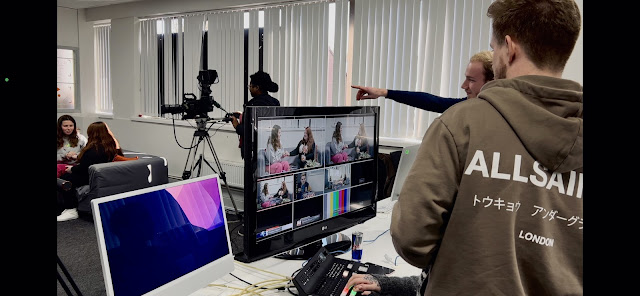Workshops (As Live)
Our Workshops during this unit have been not only productive but also absolutely essential to the success of the unit as a whole. Having various industry professionals visit during the unit allowed us a comprehensive understanding of the responsibilities, expectations and technicalities of working in a Live studio setting.
Introduction to equipment
We were introduced to the new equipment in the base room, and were given an exercise to begin to familiarise ourselves with it. We had a small set-up with 2 x Blackmagic Ursa Broadcast G2 equipped with top-mounted Studio Viewfinders on tripods and a third roaming, shoulder-mounted camera. All cameras were connected via fibre cables to a studio fibre converter and then vision-mixed on a Blackmagic mixer with the monitor displaying all 3 channel outputs.
We initially became familiar- in a very rudimentary, relaxed way- with the process of cutting and calling shots while filming scenarios among ourselves, getting to grips with some basic principles of coverage and the nature of live performance and staying with the action. (Singleton-Turner, 2011)
 |
| The Baseroom set-up where it all began. |
The Gallery
Del was great because he pulled you up on failures, that might sound scary to some, but every failure we were pulled up on meant that we found the solution thereafter; it was better to get it wrong a million times before the live show and know what to do in these unexpected situations. He also celebrated our successes after every run-through and I think that without him, the show would have been far less refined. Having the ability to work with somebody who is currently working in the industry was great too, as it gave us realistic expectations as to how the industry operates outside of the educational setting.
Watching Del direct also expanded my view of what was possible on Live broadcast and how experience greatly improves practice, it made me feel assured that this would be a role that I believed I could do, with each new venture becoming more confident in my ability to succeed.
 |
| Emily operating grams |
SOUND
SCRIPT WRITING & SUPERVISION
Having Sarah Newton on board to help us with the timing of the show and understanding the initial complexity and confusion of a Live studio script was extremely helpful. Looking at the script for the first time, the whole thing appeared incoherent, but as we sat and broke it down a line at a time, it began to look more familiar.
The studio script, after many times rehearsing, actually proved to be relatively easy to follow, despite first appearances and I enjoyed making changes and adaptations to the script as it developed alongside the Producer. Being able to make sense of a show as it's laid in front of you makes it easier to see the show holistically and make amendments and improvements. This was especially helpful when considering Directorial dilemmas such as allowing time for Camera and Talent Repo's, looking through the script and finding ways to 'buy time', while also keeping the show flowing, as well as visually interesting was a positive challenge and one that I enjoyed.
I was also pleased that during rehearsals, we never went beyond 30 seconds over, or under, the running time which I thought was a good sign that our show was well balanced in terms of the allotted time for each section and when it came to Live, we finished dead on time which is a testament to all involved and something that we wouldn't likely have been able to do without the intervention of Sarah and her undeniable influence on Emily and her many stopwatches.
REFERENCES
Crook, T. (2012) The sound handbook. Abingdon, Oxon: Routledge.
Singleton-Turner, R. (2011) Cue and cut: A practical approach to working in multi-camers studios. Manchester Univ Press.


Comments
Post a Comment